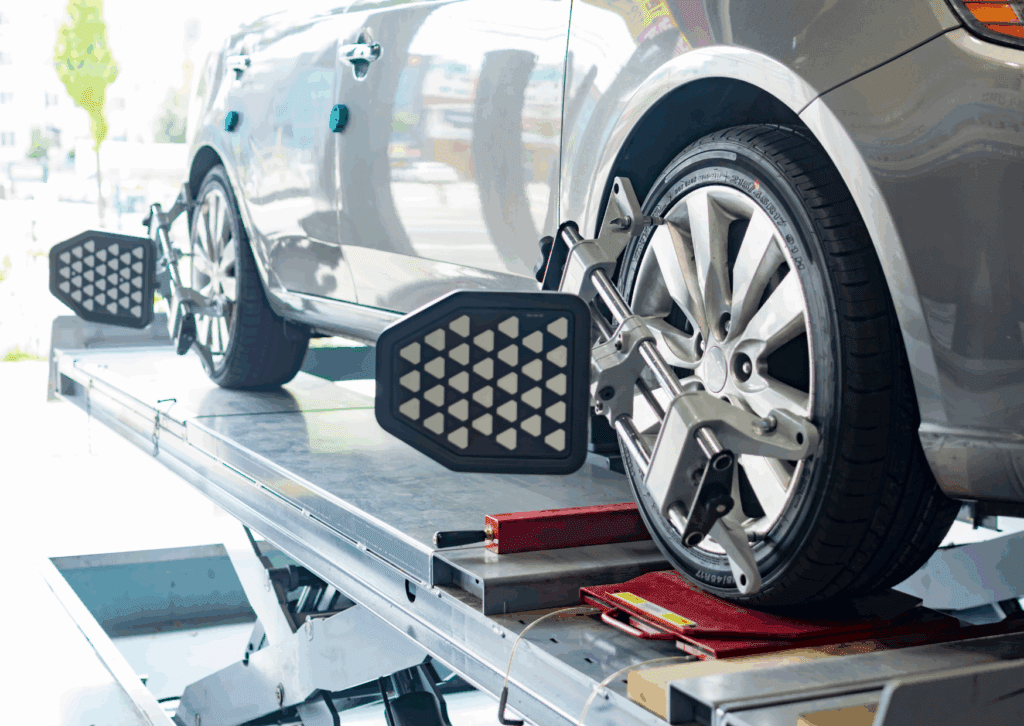We know how easy it is to overlook wheel alignment until your car starts pulling to one side, your steering wheel sits crooked, or your tires wear out faster than expected. At Metric Motors, we’ve seen firsthand how much of a difference proper alignment makes, not just for handling, but for your wallet and safety too. A precise 4 wheel alignment service helps keep your steering and suspension system working as it should, extending the life of your tires, improving your ride, and keeping your vehicle driving straight and true.
Whether you’re driving a family SUV or a compact commuter car, getting your alignment checked regularly can prevent serious issues and costly repairs. In this article, we’ll explain what 4 wheel alignment is, how it compares to other alignment types, and how to recognize when your vehicle might need one.
What Is 4 Wheel Alignment and How Is It Different from Two Wheel Alignment?

Understanding the difference between 4 wheel alignment and two-wheel alignment is key to maintaining your vehicle’s performance. A two-wheel alignment typically focuses on adjusting the front wheels, which is standard for most older or rear-wheel drive cars. In contrast, four-wheel alignment (also called 4-wheel alignment) adjusts all four wheels, perfect for vehicles with independent rear suspension or all-wheel drive systems.
The goal of any wheel alignment is to ensure your wheels are aligned properly with the road and parallel to each other. Misaligned wheels can cause uneven tread wear, reduced fuel efficiency, and handling issues. At Metric Motors, we recommend checking which alignment service your car requires based on its design and suspension system.
When Do You Need a Rear End Alignment and What Does It Involve?

A rear-end alignment ensures the rear wheels are in sync with the front. This is especially important for vehicles with independent rear suspension or when the rear axle has been affected by wear, accidents, or potholes. If your vehicle pulls to one side or feels unstable when turning, the issue may lie in the rear.
Correcting the rear-end alignment involves adjusting the toe, camber, and possibly caster on the rear axle to ensure everything lines up correctly. Proper rear-end alignment not only improves safety but also helps maximize the life of your tires.
Why Are Toe Angles Crucial to Proper Wheel Alignment?

Toe angles refer to the direction your wheels point in relation to the centerline of your vehicle. Improper toe-in or toe-out can cause significant tire wear, affect your steering, and even lead to pulling to one side.
During an alignment, technicians measure and adjust the toe angles to meet factory specifications. The smallest adjustment can make a big difference in how your car handles. At Metric Motors, we use state-of-the-art equipment to ensure accurate toe angle settings every time.
Is Four Wheel Alignment Always Necessary?

Not every vehicle requires four-wheel alignment, but many modern cars and SUVs do. If your car has an independent suspension system on all four wheels, then a four-wheel alignment is typically necessary.
A proper 4 wheel alignment improves your steering wheel’s straightness, ensures even tread on all tires, and contributes to a smoother ride. This service becomes especially important after a suspension repair, tire replacement, or hitting a large pothole.
How Does Tire Wear Indicate a Need for Alignment?

One of the clearest signs of alignment problems is uneven tread wear. If the tread on your tires wears more on one side or forms bald spots, chances are your alignment is off. This can be the result of improper camber, toe, or caster settings.
Routine tire checks and rotation can help extend tire life, but if your vehicle consistently shows signs of abnormal tread patterns, you should get your alignment checked immediately.
What Is the Thrust Angle and Why Should It Be Aligned?

The thrust angle is the direction the rear wheels are pointing in relation to the vehicle’s centerline. If it’s off, the car may drive slightly sideways, a condition known as dog tracking. This not only affects your ride but also the position of your steering wheel.
Correcting the thrust angle ensures the rear and front wheels are aligned, improving straight-line driving and reducing tire wear. If your vehicle pulls, it could be because the thrust angle is incorrect.
What’s the Difference Between Front End Alignment and End Alignment?

A front-end alignment involves adjusting the toe, camber, and caster of the front wheels. This is common in vehicles with a fixed rear axle. An end alignment may refer to either the front or rear end, depending on what needs adjustment.
Making the right adjustments to your suspension components can improve steering, reduce tire wear, and prevent pull or drift while driving. Depending on your vehicle’s setup, you may need both ends aligned.
Can a Misaligned Suspension System Damage Other Components?

Yes. A misaligned suspension system puts additional stress on other suspension components like shocks, struts, and bushings. Over time, this leads to more wear and potentially costly repairs.
Proper wheel alignment reduces that stress by distributing load evenly across your tires and suspension. Vehicles with adjustable rear suspension especially benefit from regular checks and adjustments.
What Are the Signs That Your Car Needs an Alignment Check?

Watch for these common indicators:
- The steering wheel is off-center when driving straight
- Vehicle pulls to one side
- Vibration in the steering
- Uneven tread wear on your tires
- After hitting a pothole or curb
If you notice any of these, it’s time to get your alignment checked.
How Are Alignment Angles Adjusted During Service?

Technicians use advanced equipment to measure your camber, caster, and toe angles. These angles are then adjusted to match the manufacturer’s specifications using adjustable components built into your suspension system.
This process requires precise access to alignment points on the front and rear of the vehicle. Accurate adjustment ensures better handling, less tire wear, and a smoother ride.
How Often Should You Get a Wheel Alignment for Your Vehicle?

Generally, it’s a good idea to have your wheel alignment checked once a year or every 12,000 miles. However, if your vehicle regularly drives over rough roads, carries heavy loads, or shows signs of misalignment, more frequent checks are recommended.
At Metric Motors, we inspect your steering and suspension system along with every alignment service, ensuring your car stays safe and efficient.
Ready to Improve Your Ride? Schedule Your 4-Wheel Alignment Today

If you’ve noticed steering issues, uneven tires, or if it’s simply been a while since your last alignment check, now’s the time. A professional 4-wheel alignment can save you money in the long run, keep your vehicle handling properly, and extend the life of your tires.
Call us or schedule your wheel alignment service online today. Whether you need a two-wheel alignment, rear-end alignment, or a complete four-wheel alignment, our team is ready to help you drive with confidence.
Final Thoughts
At Metric Motors, we believe keeping your vehicle aligned isn’t just about comfort, it’s about safety, performance, and long-term savings. We’ve helped Loveland drivers stay on the road longer with fewer issues and better ride quality. Trust us to take care of your alignment needs the right way.
Your wheels, tires, and suspension will thank you.
Frequently Asked Questions
1. What is 4 wheel alignment and how does it work?
4 wheel alignment is the process of adjusting all four wheels of your vehicle so they are set to the manufacturer's specifications. It ensures optimal contact with the road, proper toe angles, and straight-line stability.
2. What’s the difference between 4 wheel alignment and 2 wheel alignment?
A two wheel alignment adjusts only the front wheels, while a four wheel alignment also includes the rear wheels. Most modern cars with independent rear suspension require 4 wheel alignment for full accuracy.
3. How can I tell if my vehicle needs an alignment?
Common signs include a crooked steering wheel, your car drifting or pulling to one side, vibration, or uneven tread wear on your tires.
4. What causes wheel alignment to go out of spec?
Potholes, curb hits, worn suspension components, or even routine wear can knock your suspension system out of alignment. This is why it’s important to get your alignment checked regularly.
5. What is rear end alignment and why is it important?
Rear end alignment ensures the rear axle and rear wheels are correctly aligned with the front. If neglected, it can lead to dog tracking, thrust angle issues, and poor steering control.
6. Why are toe, camber, and caster angles important in alignment?
These angles determine how your tires meet the road. Misalignment in toe in, camber, or caster can lead to poor handling, tire wear, and an uncomfortable ride.
7. Is uneven tire wear always caused by alignment issues?
Often, yes. Uneven tread wear can indicate misaligned wheels or worn suspension components. Regular inspections can help identify and correct the root cause early.
8. What is thrust angle in alignment?
The thrust angle is the direction the rear wheels point relative to the car’s centerline. A misaligned thrust angle can cause the vehicle to drive slightly sideways, affecting both safety and tire longevity.
9. How often should I have my alignment checked?
We recommend getting your alignment checked at least once a year or every 12,000 miles. However, you should also check it after hitting a pothole, replacing tires, or noticing steering issues.
10. Can a poor alignment damage my suspension?
Yes. A misaligned wheel setup can add stress to your steering and suspension system, potentially leading to early failure of critical parts like shocks, struts, and bushings.





